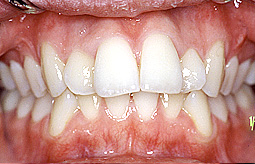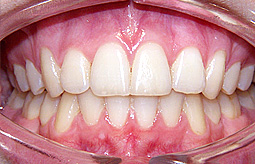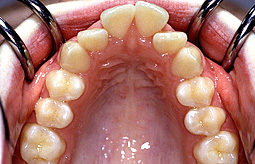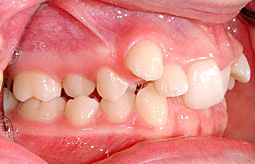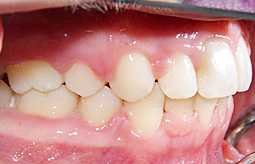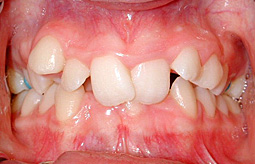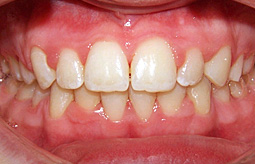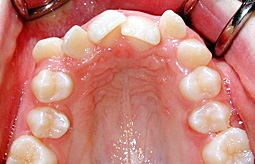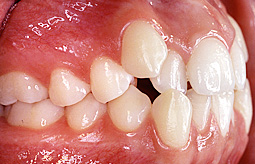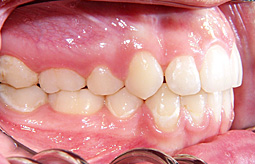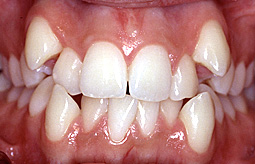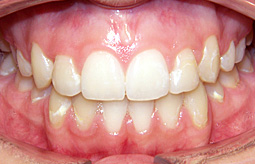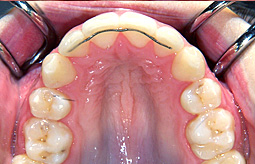Your smile is unique, so is the way we take care of it
Whether the orthodontic treatment you are considering is for you or a loved one, we understand the concerns you may have and the commitment you are about to make. So we will do our very best to put you at your ease and clearly explain the options open to you.
We will discuss the best course of treatment for you based on your individual needs and our professional experience. The type of treatment and brace required varies from patient to patient but usually involves either a removable brace or a fixed brace.
For orthodontic treatment to be successful, it does need the total co-operation of the patient and where children are concerned, the parents too. However, once your treatment is complete and you enjoy a new found confidence, you will see that the end result was worth the time and effort involved. And don’t forget - our treatments will benefit people of all ages, from children to adults.
Treatments
Fixed Braces
How is the brace fitted?
Will the treatment be painful?
How often will I need to attend the practice?
What are elastics?
How do I clean my brace and my teeth?
Do I still need to see my dentist?
What can I eat?
What can go wrong with the brace?
How long will treatment last?
Can I play sport?
What if I play a wind instrument?
Things to avoid
What Can I do to help?
How is the brace fitted?
Before the brace is fitted, you will need to do your homework by making sure that you have been cleaning your teeth properly.
When you come to us to have your brace fitted, we too will clean and dry the enamel surface of your teeth by using a special electric toothbrush. This preparation of the surface of your teeth is essential for attaching the brace successfully. At this stage, the teeth have to be kept dry so that the special glue will stick. Therefore, suction and lip holders may be used to keep your tongue, lips and saliva away from the teeth.
We will then paint the tooth surface with an etching agent which contains a weak acid. This is left for a few seconds and then washed off. A primer is then dabbed where the bracket is going to be placed.
What does this do? Tooth enamel is the hardest substance in the body. It has much more mineral content than bone. If you look at the enamel surface under a microscope you will see that it’s not smooth. It’s made up of a series of crystals and so there are little pits and nooks and crannies in the enamel surface formed by those crystals. When you etch the tooth you take away the organic layer which forms over these crystals and some of their mineral content and exposes the nooks and crannies. This helps the glue on the back of the brackets to penetrate in between the nooks and crannies of the tooth’s etched surface which gives a stronger bonding to the tooth.
Once the tooth surface has been prepared, we will then place each bracket individually into the correct position on each tooth so that they are lined up properly. The glue is then set by shining a curing light on each bracket for a few seconds.
Finally, a thin flexible wire called the archwire is then threaded through the slots of the brackets to connect them and elastic hoops hold the wire in position. These hoops can come in many colours.
Return to top
Will the treatment be painful?
The actual procedure is not painful but fitting the brace can take 20 – 45 minutes and you will need to sit still during this time!
It is quite normal to experience some discomfort for a few days after the brace has been fitted or adjusted. If you do experience some discomfort, take your usual pain killer that you would use for a headache. Always read the instructions on the packet and children should never take any medicines without first discussing with a parent or guardian. If in any doubt please ask your local pharmacist or your doctor.
If you are susceptible to mouth ulcers, these may be aggravated by wearing braces. Use a standard pain relieving gel and apply to the ulcerated area as per the instructions or use warm salt water mouth washes.
When your brace is fitted, you will be given a strip of wax to put over any bits of the brace that are rubbing or digging into your mouth. A small piece of the wax should be broken off and rolled into a small ball between your finger and thumb to soften it. It should then be applied to the part of the brace which is rubbing.
Once your mouth has adjusted to the presence of the brace, any rubbing should subside. If after a few days you are still experiencing pain, please contact the practice.
Return to top
How often will I need to attend the practice?
You will need to visit the practice regularly, around every 6 to 8 weeks to have any necessary adjustments made to your brace. During the early stages of treatment when the teeth are at their most crooked, the arch wire used will be thin and flexible to straighten them up. Towards the end of treatment when the teeth are straight, any gaps remaining will be closed up using a thicker and more rigid arch wire.
Return to top
What are elastics?
Further into treatment elastics may be attached to your braces. These are like small rubber bands that usually go from your top to your bottom teeth and are fixed to a hook on a bracket. These elastics will create the right amount of pressure to move the teeth into the proper bite position.
In order for the force to remain constant, the elastics must be worn all the time.
You will now be actively involved in your treatment as you will need to change the elastics as instructed. This is very important because if the elastics become worn out, they will not put the correct pressure on your teeth that is required to move them. You should only remove the elastics when brushing your teeth and when you eat and they should be replaced immediately.
It is a good idea to always have some spare elastics to hand so that if one breaks you can replace it immediately. If you think you may run out of elastics, let us know and we can put some in the post to you. If a hook breaks off, call the surgery so that we can organise a repair appointment for you. Do not leave it until your next appointment as this will affect your treatment.
If you fail to wear your elastics as instructed, we will notice as your teeth will not be moving as expected. This will mean a longer treatment time and will affect the results – so persevere for a bit longer until we are there!
Return to top
How do I clean my brace and my teeth?
Your teeth should be brushed well three times a day using a fluoride toothpaste. You should brush next to the gums and around the brackets especially after meals and so it is important that you carry a toothbrush with you for use during the day. A small interspace toothbrush should be used to clean carefully around the brackets. It is OK to use an electric toothbrush.
A daily fluoride mouth wash should be used at night after brushing your teeth.
When you wear a brace, the risk of gum disease, tooth decay and permanent staining and scarring (decalcification) of the teeth is greater if you do not brush your teeth frequently and properly. We will notice if your oral hygiene needs to be improved so please do not be upset if we ask you to work harder on keeping your teeth and gums in good shape – we only have your interests at heart. You may find the use of disclosing tablets helpful in making sure that you have cleaned your teeth properly at bedtime. Just ask at Reception if you would like more information.
Return to top
Do I still need to see my dentist?
It is essential that you continue to attend your dentist for regular check ups during orthodontic treatment so that your teeth can be checked for decay.
Return to top
What can I eat?
Once your brace has been fitted, we would like you to be very careful with the types of food you eat. Hard foods such as crusty bread, pizzas, nuts, apples and toast should be cut into small pieces that can be chewed. Do not bite into them as they are likely to knock the brackets off your teeth and may damage the wires. Toffees and chewing gum are also bad news for a brace.
A good diet is always important for your teeth but particularly so when wearing a brace. Drinks and food that contain sugar or acid such as sweets and fizzy drinks should be avoided. This also includes diet drinks and fruit juices. Foods that are sticky should also be avoided as these remain on the teeth longer and therefore increase the risk of decay.
Continuous snacking throughout the day will produce acids that attack the enamel on the teeth. Keep to three main meals a day with two healthy snacks - one mid morning and one mid afternoon.
Return to top
What can go wrong with the brace?
Sometimes a bracket or band that is on or around your tooth may become loose, a wire snap or a hook break off. The urgency of needing a repair appointment will depend on the stage of treatment that you are at and also whether the breakage is causing discomfort. However, if your brace has broken, please do not leave it until your next scheduled appointment as this may delay your treatment. We also would not have allocated enough time to undertake a repair during your routine appointment and so please always contact the practice as soon as possible so that we can advise you further and arrange for you to come and see us if necessary.
Loose bracket - If a bracket becomes dislodged you can temporarily reattach it using orthodontic wax. If the bracket is rubbing your gum or cheek, the wax can be placed on the bracket to give some relief until you can make an appointment. If you are nearing the end of treatment, we will want to repair your brace as soon as possible.
Broken Hook - if the hook that you attach your elastics to has broken off, try and hook the elastic around a wing on one of the brackets but we will need to see you as soon as possible.
Ligature elastic (elastic hoops) - if one of the ligature elastics or wires that secures the archwire to the bracket has broken, then contact the practice for an appointment. If you are nearing the end of treatment then we will want to make the repair as soon as possible in order to avoid relapse of tooth movement.
Protruding or broken wire - If a wire is sticking into your cheek, tongue or gum and causing pain then you will need to contact the practice as soon as possible. If you are unable to cope until you can get to the practice then you can try to push the wire into a more comfortable position or cover the end of the wire with a small piece of orthodontic wax. For health and safety reasons we do not recommend that you attempt to cut the wire yourself.
If the damaged wire has caused a painful sore, rinse your mouth with warm salt water or an antiseptic rinse. This will keep the area clean and help reduce the discomfort. You can also ask your pharmacist for an anaesthetic gel or paste to help relieve any pain caused by your brace. After a few days if the pain shows no signs of improving or the soreness becomes worse, contact the practice so we can make you an appointment.
Gaps in teeth – during the course of treatment it is quite normal for gaps to appear that had not previously been there – even when you think you are nearly at the end of treatment. Don’t panic - these will be closed before your treatment has finished.
Return to top
How long will treatment last?
Your orthodontist will tell you the estimated time required to complete your treatment but it usually takes 12 – 24 months depending on the severity of the case.
You can help by co-operating fully with the instructions given. Frequent breakages or missed appointments will lengthen the treatment time and affect the quality of the result. If you are struggling to follow our instructions please let us know.
Return to top
Can I play sport?
If you play contact sport you will need to wear a special mouth guard to protect your brace and teeth. We will be happy to discuss the types of mouth guards that are available from us.
Return to top
What if I play a wind instrument?
A fixed brace may make it more difficult to play a wind instrument. Woodwind players tend to adjust more quickly than brass players but the more you practice, the more you will get used to it.
The British Orthodontic Society produces a useful advice leaflet for musicians which you can obtain from their website
Return to top
Things to avoid
In order to look after your teeth and your brace, we ask that you avoid:
- continuous snacking throughout the day
- sticky food, toffees, boiled sweets, chewing gum, chocolate bars
- drinks that contain sugar or acid such as fizzy drinks, including diet drinks and fruit juice
- biting into hard foods such as crusty bread and rolls, pizzas, crunchy apples as this might damage the brace. Always cut hard foods up into small pieces before eating
- biting of nails and chewing on pens and pencils. The more breakages you have to your brace, the longer you will have to wear them or may even mean we have to discontinue treatment.
Return to top
What Can I do to help?
We need you to work with us so that together we can achieve the best results possible.
We ask that you:
- pay particular attention to keeping an excellent standard of oral hygiene;
- always wear the brace as instructed
- look after your brace and avoid activities and food which could damage it
- minimise sweet and acidic foods and drinks
- keep all appointments as scheduled
- attend your dentist for regular check ups
Return to top
Quad Helix
How is the brace fitted?
Will it be painful?
Will I be able to talk properly?
What can I eat?
How do I clean my brace and my teeth?
How often will I need appointments?
Do I still need to see my dentist?
What happens if I break my brace?
What can go wrong with the brace?
How long will treatment last?
What if I play sport?
What if I play a wind instrument?
Things to avoid
What can I do to help?
How is the brace fitted?
You will need to come to the practice to have impressions taken with the correct size molar bands. These impressions will be used by a skilled technician to make the brace which will then be fitted at the practice. The brace will be fixed to the two back molar teeth using dental cement.
Return to top
Will it be painful?
You will be aware of the feeling of the brace and it is not unusual to experience some discomfort for a few days after it has been fitted. You may feel some pressure on the roof of the mouth after your brace has been adjusted to maintain expansion. If necessary, you can take your usual pain killer that you would normally have for a headache. Always read the instructions on the packet and children should never take any medicines without first discussing with a parent or guardian. If in any doubt ask your local pharmacist or your doctor.
An imprint from the brace may also appear on your tongue but again this is quite normal and nothing to worry about. There may be times when the tongue becomes sore during treatment in which case use a standard pain relieving spray according to the instructions. Your pharmacist will be able to advise you as to which is most suitable. You can also use warm salt water mouth washes.
Return to top
Will I be able to talk properly?
Your speech may sound different at first but it will only last for a few days. Practice reading aloud and your speech will soon return to normal as you begin to talk more confidently with the brace in place.
Whenever you put anything in your mouth, the flow of saliva is automatically increased. Once the brace has been fitted, you may notice that you want to swallow more than usual but this will settle down.
Return to top
What can I eat?
Once your brace has been fitted, we would like you to be very careful with the types of food you eat. Hard foods such as crusty bread, pizzas, nuts, apples and toast should be cut into small pieces that can be chewed. Do not bite into them as they are likely to knock the bands off your teeth and may damage the wires. Toffees and chewing gum are also bad news for a brace.
A good diet is always important for your teeth but particularly so when wearing a brace. Drinks and food that contain sugar or acid such as sweets and fizzy drinks should be avoided. This also includes diet drinks and fruit juices. Foods that are sticky should also be avoided as these remain on the teeth longer and therefore increase the risk of decay.
Continuous snacking throughout the day will produce acids that attack the enamel on the teeth. Keep to three main meals a day with two healthy snacks - one mid morning and one mid afternoon.
Return to top
How do I clean my brace and my teeth?
Your teeth should be brushed well three times a day using a fluoride toothpaste. You must brush your teeth after meals and so it is important that you carry a toothbrush with you for use during the day. Brush the roof of your mouth well and around the brace, making sure that it is clean and free of food. If it is impossible for you to brush your teeth after eating, rinse your mouth to remove any food. A daily fluoride mouth wash should be used at night after brushing your teeth.
When you wear a brace, the risk of gum disease, tooth decay and permanent scarring (decalcification) of the teeth is greater if you do not brush your teeth frequently and properly. We will notice if your oral hygiene needs to be improved so please do not be upset if we ask you to work harder on keeping your teeth and gums in good shape – we only have your interests at heart. You may find the use of disclosing tablets helpful in making sure that you have cleaned your teeth properly at bedtime. Just ask at Reception if you would like more information.
Return to top
How often will I need appointments?
You will need regular appointments (every 6 to 8 weeks) to maintain the expansion, check that the brace is fitting properly and is comfortable and to check that both the brace and your teeth are being kept clean. We will also be checking the amount of tooth movement achieved. If you have any concerns about your brace in between your appointments, please always contact us. Never be tempted to make any adjustments to the brace yourself.
Return to top
Do I still need to see my dentist?
It is essential that you continue to attend your dentist for regular check ups during orthodontic treatment so that your teeth can be checked for decay.
Return to top
What happens if I break my brace?
If you have any problems with your brace, please contact the surgery immediately so that we can arrange the next step.
Frequent breakages may extend the treatment time and so your brace should be handled with care at all times. Do not fiddle with your brace with your tongue or fingers as this may break it or affect the way that is working.
Return to top
What can go wrong with the brace?
Sometimes the rings or molar bands that are fitting the brace to the two back molar teeth become uncemented or the W shaped wire may snap. If this happens contact the practice so that an appointment can be made for a repair.
Return to top
How long will treatment last?
Your orthodontist will tell you the estimated time required to complete your treatment. The overall treatment time can vary from 4 months to 9 months and will depend on the severity of the case but the treatment time can be affected by a number of factors including lack of growth and individual response to treatment.
You can help by co-operating fully with the instructions given. Frequent breakages or missed appointments will lengthen the treatment time and affect the quality of the result. If you are struggling to follow our instructions please let us know.
Return to top
What if I play sport?
If you play contact sport you will need to wear a special mouth guard to protect your brace and teeth. We will be happy to discuss the types of mouth guards that are available from us.
Return to top
What if I play a wind instrument?
The British Orthodontic Society produces a useful advice leaflet for musicians which you can obtain from their website
Return to top
Things to avoid
In order to look after your teeth and your brace, you should avoid:
- toffees, boiled sweets, chewing gum, chocolate bars
- drinks that contain sugar or acid such as fizzy drinks, including diet drinks and fruit juice
- biting into hard foods such as crusty bread and rolls, pizzas, crunchy apples as this might damage the brace. Always cut hard foods up into small pieces before eating
- biting on pens, pencils or chewing your nails. The more breakages you have to your brace, the longer you will have to wear them or may even mean we have to discontinue treatment.
Return to top
What can I do to help?
We need you to work with us so that together we can achieve the best results possible.
We ask that you:
- pay particular attention to keeping an excellent standard of oral hygiene;
- look after your brace and avoid activities and food which could damage it
- minimise sweet and acidic foods and drinks
- keep all appointments as scheduled
- attend your dentist for regular check ups
Return to top
Removable Brace
They are sometimes recommended for correcting a simple problem in younger patients who have yet to obtain most of their permanent teeth or for moving one or two teeth at a time. Fixed braces may be needed later to make the teeth straight and fit together.
How is the brace fitted?
Will it be painful?
Will I be able to talk properly?
Do I eat with my brace in?
What can I eat?
How often do I wear the brace?
How do I clean my brace and my teeth?
How often will I need appointments?
Do I still need to see my dentist?
What happens if I lose or break my Brace?
How long will treatment last?
What if I play sport?
What if I play a wind instrument?
Things to avoid
What Can I do to help?
How is the brace fitted?
You will need to come to the practice to have your brace fitted. At this visit your orthodontist will make any necessary adjustments to the brace so that it fits properly and comfortably in your mouth and will also activate any wires, screws or springs that are being used as part of your treatment.
You will be shown how to correctly and carefully take the brace in and out of your mouth by using the clips at the back. This will help prevent damage to the delicate wires that move your teeth. If your brace has springs, you will also be shown how to place these in the correct position. Your brace won’t work if the springs are not in the right place to move your teeth.
Return to top
Will it be painful?
You will be aware of the feeling of the brace and it is not unusual to experience some discomfort for a few days after it has been fitted. This should improve as you get used to wearing it. Don’t give up! If you stop wearing your brace, you will still have to go through the discomfort when you start wearing it again. It may also no longer fit as your teeth are likely to have moved back to their original position.
If necessary, you can take your usual pain killer that you would normally have for a headache. Always read the instructions on the packet and never take any medicines without first discussing with a parent or guardian. If in any doubt, please ask your local pharmacist or your doctor.
Return to top
Will I be able to talk properly?
After the brace has been fitted, you may notice a strange taste in your mouth but this should go away within a few hours.
Your speech may sound different at first but it will only last for a few days. Practice reading aloud and your speech will soon return to normal as you begin to talk more confidently with the brace in place.
Whenever you put anything in your mouth, the flow of saliva is automatically increased. Once the brace has been fitted, you may notice that you want to swallow more than usual but this will settle down.
You will find the whole process much easier to deal with if the brace is left in place as much as possible in the first few days and is not constantly being taken in and out of the mouth.
Return to top
Do I eat with my brace in?
Sometimes it is important to eat with the brace in and sometimes it is important to take it our for your main meals. Listen carefully to what your orthodontist tells you and if in any doubt, contact the practice.
Return to top
What can I eat?
A good diet is always important for your teeth but particularly so when wearing a brace. Drinks and food that contain sugar or acid such as sweets and fizzy drinks should be avoided. This also includes diet drinks and fruit juices. Foods that are sticky should also be avoided as these remain on the teeth longer and therefore increase the risk of decay.
Continuous snacking throughout the day will produce acids that attack the enamel on the teeth. Keep to three main meals a day with two healthy snacks - one mid morning and one mid afternoon.
Return to top
How often do I wear the brace?
Your orthodontist will tell you when to wear your removable brace but in most cases it should be worn at all times and only taken out for eating if advised, cleaning, playing contact sports or when you go swimming. Always keep your brace in a protective box when not wearing it. These can be purchased at Reception.
Because removable braces are easily taken out, you may be tempted to wear it less than advised. This is likely to affect the treatment time and the quality of the end result - so work with us and keep wearing it. It ‘ll be worth it!
Return to top
How do I clean my brace and my teeth?
Your teeth should be brushed well three times a day using a fluoride toothpaste. You must brush the plate and your teeth after meals and so it is important that you carry a toothbrush with you for use during the day. Take the plate out to clean it and brush both sides thoroughly but gently taking care not to damage the wires. Also brush the roof of your mouth as well as your teeth to remove any food. If it is impossible for you to brush your teeth after eating, remove the plate and rinse it with water and rinse your mouth to remove any food before replacing the brace. A daily fluoride mouth wash should be used at night after brushing your teeth.
It is recommended that you use a special cleaning agent on a regular basis such as Retainer Brite. This will kill bacteria and help to keep the brace fresh. Never soak the brace in bleach and do not use boiling water to clean it. You should also never put the brace in the dishwasher!
When you wear a brace, the risk of gum disease, tooth decay and permanent scarring (decalcification) of the teeth is greater if you do not brush your teeth frequently and properly. We will notice if your oral hygiene needs to be improved so please don’t be upset if we ask you to work harder on keeping your teeth and gums in good shape – we only have your interests at heart. You may find the use of disclosing tablets helpful in making sure that you have cleaned your teeth properly at bedtime. Just ask at Reception if you would like more information.
Return to top
How often will I need appointments?
You will need regular appointments (every 6 to 8 weeks) to check that the brace is fitting properly, is comfortable and to check that both the brace and your teeth are being kept clean. We will also be checking the amount of tooth movement achieved. If you have any concerns about your brace in between your appointments, please always contact us. Never be tempted to make any adjustments to the brace yourself.
Return to top
Do I still need to see my dentist?
It is essential that you continue to attend your dentist for regular check ups during orthodontic treatment so that your teeth can be checked for decay.
Return to top
What happens if I lose or break my Brace?
If you have any problems with your brace, please contact the surgery immediately so that we can arrange the next step.
Frequent breakages may extend the treatment time and so your brace should be handled with care at all times. You should take it in and out of the mouth as instructed, using the clasps around the back teeth and never flick it on and off your teeth with your tongue as this will loosen the clasps and weaken the wires.
The safest and most effective place for your brace is in your mouth – so don’t get carried away by the fact that it is called a removable brace! If you leave it lying around, there is a high chance that it will get broken. So when it is not in your mouth, always keep it in a plastic, protective box.
We always warn patients that dogs love to chew orthodontic braces so extra care should be taken if you have a pet or if you stay with a friend or relative who has a pet.
If you eat out, always take your brace box with you so that you can pop it in there before eating. Never wrap it in a napkin as it has been known for these to be thrown in a bin or even flushed down the loo!
If your brace is lost or broken beyond repair and a replacement needs to be made, a fee will be charged for the replacement.
Return to top
How long will treatment last?
Your orthodontist will tell you the estimated time required to complete your treatment. To correct the teeth, the forces applied by the plate must be as constant as possible to achieve maximum tooth movement. Once the bite has been corrected there is usually a period of time when the brace will be worn at nights only so that the teeth are allowed to settle into their new positions.
The overall treatment time can vary from 6 months to 2 years and will depend on the severity of the case but the treatment time can be affected by a number of factors including lack of growth and individual response to treatment.
You can help by co-operating fully with the instructions given. Frequent breakages, missed appointments or failure to wear the brace as often as advised will lengthen the treatment time and affect the quality of the result. If you are struggling to follow our instructions or are having difficulty in wearing the brace as instructed, please let us know.
Return to top
What if I play sport?
With a lot of sports it’s OK to wear the brace. For contact sports where a gum shield is normally worn, then you will need to remove the brace and replace it with the gum shield. We also suggest that you remove the brace when you go swimming in case it is dropped and lost in the water. Keep the brace in a protective box for safe storage until you are ready to put it back in.
Return to top
What if I play a wind instrument?
You can remove your brace to play a wind instrument. However, leaving your brace out for long periods will affect treatment and so please tell your orthodontist how often you need to practice.
The British Orthodontic Society produces a useful advice leaflet for musicians which you can obtain from their website.
Return to top
Things to avoid
In order to look after your teeth and your brace, we ask that you avoid:
- continuous snacking throughout the day
- toffees, boiled sweets, chewing gum, chocolate bars
- drinks that contain sugar or acid such as fizzy drinks, including diet drinks and fruit juice
- biting into hard foods such as crusty bread and rolls, pizzas, crunchy apples as this might damage the brace if you are asked to wear it whilst eating. Always cut hard foods up into small pieces
- biting on pens, pencils or chewing your nails. The more breakages you have to your brace, the longer you will have to wear them or may even mean we have to discontinue treatment.
Return to top
What Can I do to help?
We need you to work with us so that together we can achieve the best results possible.
We ask that you:
- pay particular attention to keeping an excellent standard of oral hygiene;
- always wear the brace as instructed
- look after your brace and avoid activities and food which could damage it
- minimise sweet and acidic foods and drinks
- keep all appointments as scheduled
- attend your dentist for regular check ups
Return to top
Twin Block
Twin blocks are usually used to correct an overjet. This is where the top teeth stick out over the bottom teeth and although it may look like the top teeth are too far forward, it may also be due to the fact that the jaw is too far back. Normally, the bite of the top teeth in front of the lower ones is in the region of 2mm to 4 mm and this will be measured at your assessment. If your overjet is significantly greater than this, a twin block brace may be recommended and on average will reduce the overjet by approximately 1 mm per month. In cases where the jaw is too narrow, the plate may have an expansion screw which is used to widen the arch and therefore lessens the need to have permanent teeth taken out to make space.
Functional braces need to be used on children who are in their growth spurt which is usually between the ages of 12 to 14 years but may vary according to growth. Worn reliably and at the right time, treatment with a twin block brace not only produces a beautiful smile but can have dramatic results on the jaw line and profile of the patient.
How is the brace fitted?
Will it be painful?
Will I be able to talk properly?
Do I eat with my brace in?
What can I eat?
How often do I wear the brace?
How do I clean my brace and my teeth?
How often will I need appointments?
Do I still need to see my dentist?
What happens if I lose or break my Brace?
How long will treatment last?
What if I play sport?
What if I play a wind instrument?
Things to avoid
What Can I do to help?
How is the brace fitted?
We will take impressions of your teeth and a wax bite to record your teeth biting in a forward position. This will then be used by a skilled technician to make your brace which will be fitted at the practice. At this visit your orthodontist will make any necessary adjustments to the brace so that it fits properly and comfortably in your mouth and will also instruct you how to activate any screws that are being used as part of your treatment.
You will be shown how to correctly and carefully take the brace in and out of your mouth. You should always first position the wire on your teeth and then firmly press the plates into place by using your thumbs on the clasps at the back. To remove, the brace should be eased off gently from each side. The wire that fits across the front teeth is easily damaged so avoid putting pressure on this. Never use your tongue to flip the brace in and out of your mouth as this will loosen the wires and clasps and break the brace.
Return to top
Will it be painful?
You will be aware of the feeling of the brace and it is not unusual to experience some discomfort for a few days after it has been fitted. If necessary, you can take your usual pain killer that you would normally have for a headache. Always read the instructions on the packet and never take any medicines without first discussing with a parent or guardian. If you are in any doubt ask your local pharmacist or your doctor.
Any discomfort should improve as you get used to wearing it. Don’t give up! If you stop wearing your brace, you will still have to go through the discomfort when you start wearing it again.
Return to top
Will I be able to talk properly?
After the brace has been fitted, you may notice a strange taste in your mouth but this should go away within a few hours. Your speech may also sound different at first but it will only last for a few days. Practice reading aloud and your speech will soon return to normal as you begin to talk more confidently with the brace in place. In order to maintain the correct bite position it is important to remember to keep your lips together and breathe through your nose.
Whenever you put anything in your mouth, the flow of saliva is automatically increased. Once the brace has been fitted, you may notice that you want to swallow more than usual but this will settle down.
You will find the whole process much easier to deal with if the brace is left in place as much as possible in the first few days and is not constantly being taken in and out of the mouth.
Return to top
Do I eat with my brace in?
You should remove your brace to eat your main meals but place it immediately in a brace box for safe storage until you have finished eating.
Return to top
What can I eat?
A good diet is always important for your teeth but particularly so when wearing a brace. Drinks and food that contain sugar or acid such as sweets and fizzy drinks should be avoided. This also includes diet drinks and fruit juices. Foods that are sticky should also be avoided as these remain on the teeth longer and therefore increase the risk of decay.
Continuous snacking throughout the day will produce acids that attack the enamel on the teeth. Keep to three main meals a day with two healthy snacks - one mid morning and one mid afternoon.
Return to top
How often do I wear the brace?
Your orthodontist will tell you when to wear your brace but in most cases it should only be removed for eating main meals, cleaning, playing contact sports or when you go swimming. Always keep your brace in a protective box when not wearing it.
Because removable braces are easily taken out, you may be tempted to wear it less than advised. We will expect the prominence of your teeth to reduce by about 1 mm at each visit so we will know if you have not been wearing your brace. This will affect the treatment time and the quality of the end result - so work with us. It ‘ll be worth it!
Return to top
How do I clean my brace and my teeth?
Your teeth should be brushed well three times a day using a fluoride toothpaste. You must brush your teeth after meals and so it is important that you carry a toothbrush with you for use during the day. Always brush the roof of your mouth as well as your teeth to remove any food. Your twin block should be brushed and rinsed in luke warm water.
If it is impossible for you to brush your teeth after eating, remove the twin block and rinse it with water and rinse your mouth to remove any food before replacing the brace. A daily fluoride mouth wash should be used at night after brushing your teeth.
It is recommended that you use a special cleaning agent on a regular basis such as Retainer Brite. This will kill bacteria and help to keep the brace fresh. Never soak the brace in bleach and do not use boiling water to clean it. You should also never put it in the dishwasher!
When you wear a brace, the risk of gum disease, tooth decay and permanent scarring (decalcification) of the teeth is greater if you do not brush your teeth frequently and properly. We will notice if your oral hygiene needs to be improved so please do not be upset if we ask you to work harder on keeping your teeth and gums in good shape – we only have your interests at heart. You may find the use of disclosing tablets helpful in making sure that you have cleaned your teeth properly at bedtime. Just ask at Reception if you would like more information.
Return to top
How often will I need appointments?
You will need regular appointments (every 6 to 8 weeks) to check that the brace is fitting properly, is comfortable and to check that both the brace and your teeth are being kept clean. We will also be checking on the amount of tooth movement achieved. If you have any concerns about your brace in between your appointments, please always contact us. Never be tempted to make any adjustments to the brace yourself.
Return to top
Do I still need to see my dentists?
It is essential that you continue to attend your dentist for regular check ups during orthodontic treatment so that your teeth can be checked for decay.
Return to top
What happens if I lose or break my brace?
If you have any problems with your brace, please contact the surgery immediately so that we can arrange the next step.
Frequent breakages may extend the treatment time and so your brace should be handled with care at all times. You should take it in and out of the mouth as instructed, using the clasps around the back teeth and never flick it on and off your teeth with your tongue as this will loosen the clasps and weaken the wires.
The safest and most effective place for your brace is in your mouth. If you leave it lying around, there is a high chance that it will get broken so when it is not in your mouth, always keep it in a plastic, protective box.
We always warn patients that dogs love to chew orthodontic braces so extra care should be taken if you have a pet or if you stay with a friend or relative who has a pet.
If you eat out, always take your brace box with you so that you can pop it in there before eating. Never wrap it in a napkin as it has been known for these to be thrown in a bin or even flushed down the loo!
If your brace is lost or broken beyond repair and a replacement needs to be made, a fee will be charged for the replacement.
Return to top
What can go wrong with the brace?
Loose Twin Block: Depending on the stage of treatment that you are at, if you fail to wear your brace very much during the day, your teeth may start to move back to their original position. This may result in the twin block not fitting properly and so is likely to fall out if you try to wear it at night.
Top plate snapped: If you are having to use an expansion screw, the plastic can tend to be weaker where the screw is. If is comfortable and staying in then continue to wear it but make an appointment. We may be able to repair it so please don’t throw it away!
Lower Plate snapped: Keep wearing the top plate but do not attempt to wear the lower one. It may be possible to repair it so please don’t throw it away! Phone to make an appointment so that impressions can be taken for a replacement or a repair
Wire has broken: Sometimes the front wire can break where it enters the plastic plate resulting in the wire flopping onto the lip. Make an appointment to see the orthodontist but continue to wear the brace as much as possible.
Lost Twin Block: Contact us immediately.
Return to top
How long will treatment last?
Your orthodontist will tell you the estimated time required to complete your treatment. To correct the teeth, the forces applied by the plate must be as constant as possible to achieve maximum tooth movement. Once the bite has been corrected there is usually a period of time when the brace will be worn at nights only to allow the teeth to settle into their new positions.
The overall treatment time can vary from 9 months to 12 months and will depend on the severity of the case but the treatment time can be affected by a number of factors including lack of growth and individual response to treatment.
You can help by co-operating fully with the instructions given. You should notice changes fairly quickly if you wear your brace well. Frequent breakages, missed appointments or failure to wear the brace as often as advised will lengthen the treatment time and affect the quality of the result. If you are struggling to follow our instructions or are having difficulty in wearing the brace as instructed, please let us know.
As twin blocks are used to align the jaw, if the teeth themselves are crooked it is quite common for patients to continue treatment with fixed braces to straighten the teeth once the twin block stage is completed.
Return to top
What if I play sport?
With a lot of sports it’s OK to wear the brace. For contact sports where a gum shield is normally worn, then you will need to remove the brace and replace it with the gum shield. We also suggest that you remove the brace when you go swimming in case it is dropped and lost in the water. Keep the brace in a protective box for safe storage until you are ready to put it back in.
Return to top
What if I play a wind instrument?
You can remove your brace to play a wind instrument. However, leaving your brace out for long periods will affect treatment and so please tell your orthodontist how often you need to practice.
The British Orthodontic Society produces a useful advice leaflet for musicians which you can obtain from their website.
Return to top
Things to avoid
In order to look after your teeth and your brace, we ask that you avoid:
- continuous snacking throughout the day
- toffees, boiled sweets, chewing gum, chocolate bars
- drinks that contain sugar or acid such as fizzy drinks, including diet drinks and fruit juice
- biting on pens, pencils or chewing your nails. The more breakages you have to your brace, the longer you will have to wear them or may even mean we have to discontinue treatment.
Return to top
What can I do to help?
We need you to work with us so that together we can achieve the best results possible.
We ask that you:
- pay particular attention to keeping an excellent standard of oral hygiene;
- always wear the brace as instructed
- look after your brace and avoid activities and food which could damage it
- minimise sweet and acidic foods and drinks
- keep all appointments as scheduled
- attend your dentist for regular check ups.
Return to top
Invisalign®/Invisalign® Teen
Does my age matter?
How does Invisalign® work?
Will it be painful?
Will I be able to talk properly?
Do I eat with the aligners in?
How often do I wear the aligners?
How do I clean my aligners and my teeth?
What can I eat?
How often will I need appointments?
What happens if I lose or break my aligners?
What can go wrong with the brace?
How long will treatment last?
What if I play sport?
What if I play a wind instrument
Will Invisalign® be suitable for me?
Does my age matter?
Invisalign Teen® is a new product that has been developed for teenage patients. It gives all the great benefits of the regular Invisalign® system and can be used on patients between 11 and 19 years of age. For more information or for a consultation, please contact us.
Return to top

How does Invisalign® work?
Your orthodontist will map out a treatment plan and take impressions of your teeth which will be sent to Invisalign®. These impressions will be entered into a computer and turned into a 3D computer image based on the complete treatment plan as instructed by your orthodontist. The image will show the movement of your teeth from start to finish and is accessible online so that you can see step by step how your teeth will move into their final position. You and your orthodontist will view this image together so that you can both discuss the final position and decide whether any changes should be made to the treatment plan. That way you can be sure that you will achieve the smile you have always wanted.
Once the treatment plan has been agreed, the orthodontist will give the go ahead to Invisalign® to create a series of clear aligners that will gradually move your teeth into position during the treatment period. These aligners are custom made for your teeth and each aligner will be worn for about two weeks before moving on to the next aligner in the series.
Return to top
Will it be painful?
You may experience some initial discomfort. This is usually no more than a feeling of pressure as the teeth are being moved. An advice sheet is provided when the aligners are fitted.
Your orthodontist may advise you to take your usual pain killer that you would normally have for a headache. Always read the instructions on the packet and children should never take any medicines without first discussing with a parent or guardian. If in any doubt ask your local pharmacist or doctor.
Return to top
Will I be able to talk properly?
You may find that you have a slight lisp to start with but this should settle down within a few days as your tongue gets used to having the aligners in. Practice reading aloud and your speech will soon return to normal as you begin to talk more confidently with the aligners in place.
Return to top
Do I eat with the aligners in?
You should remove your aligners to eat your main meals but place them immediately in a brace box for safe storage until you have finished eating.
Return to top
How often do I wear the aligners?
Your orthodontist will tell you when to wear your aligners but usually it is 22/24 hours, 7 days a week and should only be removed for eating, cleaning, playing contact sports or when you go swimming. Always keep your aligners in a protective box when not wearing them.
Because aligners are easily taken out, you may be tempted to wear them less than advised. This will affect the treatment time and the quality of the end result - so work with us. It ‘ll be worth it!
Return to top
How do I clean my aligners and my teeth?
You remove your aligners to clean your teeth and so maintaining good oral hygiene couldn’t be easier. Your teeth should be brushed well three times a day using a fluoride toothpaste and so it is important that you carry a toothbrush with you for use during the day.
If it is impossible for you to brush your teeth after eating, rinse your mouth to remove any food before replacing the aligners. A daily fluoride mouth wash should be used at night after brushing your teeth.
Because you remove your aligners to eat, keeping them clean is simple. It is recommended that you use a special cleaning agent on a regular basis such as Retainer Brite. This will kill bacteria and help to keep the aligners fresh.
Return to top
What can I eat?
That’s the good news! Because you remove your aligners to eat, you can continue to enjoy your food. However, we would still encourage you to have a healthy, sensible diet. Avoiding things like continuous snacking throughout the day and food and drink that contain sugar or acid will significantly reduce the risk of tooth decay.
Return to top
How often will I need appointments?
You will need regular appointments (every 4 to 6 weeks) to check that movement is progressing as expected.
Return to top
 What happens if I lose or break my aligners?
What happens if I lose or break my aligners? If you have any problems with your aligners, please contact the surgery immediately so that we can arrange the next step.
Frequent breakages may extend the treatment time and so your aligners should be handled with care at all times. You should take them in and out of the mouth as instructed.
The safest and most effective place for your aligners is in your mouth. If you leave them lying around, there is a high chance that they will get broken so when they are not in your mouth, always keep them in the plastic, protective box which will be given to you.
We always warn patients that dogs love to chew orthodontic braces so extra care should be taken if you have a pet or if you stay with a friend or relative who has a pet.
If you eat out, always take your aligner box with you so that you can pop them in there before eating. Never wrap your aligners in a napkin as it has been known for these to be thrown in a bin or even flushed down the loo!
If your aligner is lost or broken beyond repair, where possible we will move on to the next aligner in the series. However, if this is not possible and a replacement needs to be made, a fee will be charged for the replacement.
Return to top
What can go wrong with the brace?
Sometimes an aligner may break or split or if you don’t wear the aligner reliably it may also lose its fit so that you will have difficulty seating the aligner properly over the teeth. Always contact the practice if you are having problems with your aligners.
Return to top
How long will treatment last?
Your orthodontist will tell you the estimated time required to complete your treatment. The overall treatment time can vary from 6 months to 24 months and will depend on the severity of the case.
You should notice changes fairly quickly if you wear them full time day and night as instructed.
Return to top
What if I play sport?
Take the aligners out when you play contact sport or when you go swimming and keep them in a protective box for safe storage until you are ready to put them back in.
Return to top
What if I play a wind instrument?
You can remove your aligners to play a wind instrument. However, leaving them out for long periods will affect treatment and so please tell your orthodontist how often you need to practice.
The British Orthodontic Society produces a useful advice leaflet for musicians which you can obtain from their website.
Return to top
Will Invisalign® be suitable for me?
Invisalign® is becoming more and more popular with patients because they are virtually unnoticeable and produce really pleasing results. It can sometimes be used as part of a treatment plan where other types of braces are used alongside Invisalign®.

If you are interested in the Invisalign® technique to align your teeth please contact the practice so that an assessment appointment can be arranged. Our experienced orthodontists will be able to discuss with you your concerns about the alignment of your teeth and will give you more information about the Invisalign® technique.
Return to top
Retainers
The retainers hold newly straightened teeth in position while the surrounding gum and bone settles. The retainers can be removable or fixed depending on the original problem but if they are not worn, the teeth are likely to drift towards their original positions and can only be corrected by wearing braces again. Types of retainers most commonly used are:
Hawley Retainers: This is a removable retainer and is a plastic plate with wires that clip over the teeth to hold them in their new position.
Essix Retainers: This is a removable retainer and is a clear plastic tray that fits over the teeth.
Fixed Retainers: Also called bonded retainers and as the name suggests these cannot be removed. A thin wire is glued behind the front teeth to hold the teeth in place.
How are retainers fitted?
Will it be painful?
Will I be able to talk properly?
What can I eat?
How often do I wear the retainers?
How do I clean my retainers and my teeth?
How Often will I need appointments?
Do I still need to see my dentists?
What happens if I lose or break my retainers?
What can go wrong with the retainer?
How long will retention last?
What if I play sport?
What if I play a wind instrument?
How are retainers fitted?
We will take impressions of your teeth and these will be used to make your retainers which will be fitted at the practice. Your orthodontist will make any necessary adjustments to the retainers so that they fit properly and comfortably in your mouth and will also instruct you on how to take them in and out.
Return to top
Will it be painful?
There should be no real discomfort. They are designed to fit snugly and so there may be a feeling of tightness which shows they are doing their job.
Return to top
Will I be able to talk properly?
You may find that you have a slight lisp to start with but this should settle down within a few days as your tongue gets used to having the retainers in. Practice reading aloud and your speech will soon return to normal as you begin to talk more confidently with the retainers in place.
Return to top
What can I eat?
By now you are probably quite familiar with the importance of having a sensible diet so that the risk of tooth decay is reduced.
If you are wearing removable retainers you will be able to eat quite normally as they should be removed before eating and placed immediately in a brace box for safe storage until you have finished your meal. We would always recommend that you avoid continuous snacking and also foods that contain sugar or acid. If you are wearing fixed retainers then you will need to take more care and avoid eating hard or sticky food.
Return to top
How often do I wear the retainers?
Your orthodontist will tell you when to wear your retainers but usually it is full time for the first 6 months and then night time only for 6 months. They should only be removed for eating, cleaning, playing contact sports or when you go swimming. Always keep your retainers in a protective box when not wearing them. Obviously fixed retainers are glued to the teeth and remain permanently in your mouth until removed by the orthodontist.
Because your teeth are likely to move throughout your lifetime, you will be advised to continue to wear your removable retainers during the night so that the position of your teeth can be kept in check. The number of times a week they need to be worn varies but usually can be reduced to a couple of times a week eventually.
In cases where relapse is likely your orthodontist may recommend that permanent retention is needed to keep the position of your teeth stable. This will be discussed with you as part of the treatment planning.
Return to top
How do I clean my retainers and my teeth?
Whether your retainers are fixed or removable, your teeth should be brushed well three times a day using a fluoride toothpaste. Therefore it is important that you carry a toothbrush with you for use during the day. Because a removable retainer is taken out when you clean your teeth, good oral hygiene can be easily maintained as you will be able to brush your teeth as normal. Hawley retainers should be handled with care when cleaning so as not to damage the wires.
However, if you have a fixed retainer then you will need to take extra care to keep it clean by brushing around the wire thoroughly to remove any food that may have become trapped. You will also need to make sure that the retainer continues to do its job by examining it regularly to check that nothing has become loose.
Where it is impossible for you to brush your teeth after eating, rinse your mouth to remove any food before replacing the retainer. A daily fluoride mouth wash should be used at night after brushing your teeth.
It is recommended that you regularly use a special cleaning agent on your removable retainers such as Retainer Brite. This will kill bacteria and help to keep the retainers fresh. Never soak the retainers in bleach and do not use boiling water to clean them. You should also never put your retainers in the dishwasher!
Return to top
How often will I need appointments?
Now that you are in the final stages of treatment, you will only need to attend the practice to have your retainer checked. This usually means about 3 visits over the course of a year.
Return to top
Do I still need to see my dentists?
It is essential that you continue to attend your dentist for regular check ups during retention so that your teeth can be checked for decay.
Return to top
What happens if I lose or break my retainers?
Your retainer should be handled with care at all times and if removable they should be taken in and out of the mouth as instructed.
The safest and most effective place for your retainers is in your mouth. If you leave them lying around, there is a high chance that they will get broken so when they are not in your mouth, always keep them in a plastic, protective box.
We always warn patients that dogs love to chew orthodontic braces so extra care should be taken if you have a pet or if you stay with a friend or relative who has a pet.
If you eat out, always take your brace box with you so that you can pop them in there before eating. Never wrap your retainers in a napkin as it has been known for these to be thrown in a bin or even flushed down the loo!
If your retainer does not fit properly or if you have lost or broken your retainer please phone the practice as soon as possible. Do not wait until your next appointment as your teeth may move if you are unable to wear it in the correct manner. A charge will be made if a replacement needs to be made.
Return to top
What can go wrong with the retainer?
Do not use your tongue to flick the retainer in and out of your mouth as this will weaken it and cause it to break.
If your retainer no longer fits properly, it is because you have not been wearing it as instructed and your teeth have moved. New impressions may need to be taken and a replacement retainer made.
If you have a fixed retainer, a section may become unglued which means it will not be giving the correct support. It will need to be rebonded as soon as possible.
If something is wrong with your retainer, please phone the practice as soon as possible. Do not wait until your next appointment as your teeth may move if you are unable to wear it in the correct manner.
Return to top
How long will retention last?
Your orthodontist will tell you how long you will need to wear your retainers for. You can help by co-operating fully with the instructions given. Your retainers are made to fit the final position of your teeth exactly and they will only work if you wear them as advised. Don’t be tempted to think that the job is done once your braces have been removed. If you don’t wear them as often as instructed, your teeth may move and then your retainers will no longer fit.
If you are struggling to follow our instructions or are having difficulty in wearing the retainers as instructed, please let us know.
Return to top
What if I play sport?
Take the retainer out when you play contact sport and when you go swimming and keep it in a protective box for safe storage until you are ready to put it back in.
Return to top
What if I play a wind instrument?
You can remove your retainers to play a wind instrument. However, leaving your retainers out for long periods may result in your teeth moving so please tell your orthodontist how often you need to practice.
If you have a fixed retainer the more you practice the more you will get used to it.
The British Orthodontic Society produces a useful advice leaflet for musicians which you can obtain from their website.
Return to top
Impacted Teeth
Impacted teeth tend to run in the family and may be due to crowding, failure of the baby tooth to come out or a supernumerary (extra) tooth may be blocking the way. If the impacted tooth is unable to follow its normal path for eruption, it may find another route which then takes it out of its proper position. However there are occasions when teeth are impacted for no apparent reason.
A tooth may be impacted without producing any symptoms or without causing damage to other teeth. If this is the case, it may be best to leave it where it is but kept under review to make sure that the position does not change. However, there are a number of reasons why impacted teeth should be treated:
- there is the possibility that the unerupted tooth could lead to the development of a cyst;
- if the impacted tooth has contact with the tooth next to it then it may cause damage to that tooth;
- the impacted tooth may be in an abnormal position such as the palate;
- there may be a gap where the baby tooth has come out and the permanent tooth remains buried;
- the function and alignment of other teeth can be affected.
It may be that by extracting other teeth and the use of braces, space will be made for the impacted tooth to come through. Sometimes, a minor operation may be needed to expose part of the impacted tooth which may encourage eruption if the tooth has not yet become totally stuck. This is usually done under general anaesthetic by an oral surgeon. If the tooth is going to need help to guide it into its proper place in the dental arch, a bracket that has a small gold chain attached to it will be put on the exposed tooth by the oral surgeon. This means that the orthodontist can control the movement of the tooth by using the chain so that the tooth can gradually be pulled down into the correct position.
Unfortunately there may be times when an impacted canine that is causing problems cannot be saved and will need to be extracted. Where this leaves a gap, it may be possible to move forward the premolar tooth that is normally next to the canine and shape it so that it resembles the canine. Although this would avoid the use of replacement teeth, it may not necessarily produce the most pleasing cosmetic result and so you may be advised to discuss with your dentist the option of either an implant or a bridge to replace the missing tooth.
Missing Teeth
This can be very upsetting for patients who may worry about their smile and for parents who want their children to be able to smile with confidence.
Missing teeth may mean that the other teeth around the gap are not being held in place and therefore they too may tend to roam from their ideal position. Biting pressure may also not be spread evenly across all the teeth which can place additional wear and tear on those teeth that are doing all the hard work.
With a combination of orthodontics and restorative dentistry, a more natural looking smile can be achieved. The most common missing teeth are the small ones at the top next to the two big front teeth (upper lateral incisors) and also the fifth teeth from the front (second premolars).
The lateral incisors are very noticeable when we smile and so it is important that the treatment plan achieves the best cosmetic result possible. Using fixed braces, the canine tooth can be moved forward into the incisor position and reshaped so that it fits. This avoids the use of replacement teeth but may not necessarily have the most pleasing cosmetic result due to the difference in tooth colour and shape. It may be that the best result for the function of the teeth and the cosmetic appearance would be to move the canines back to make space for a replacement tooth which is attached to the brace and retainer. Once the orthodontic treatment is complete, you may wish to discuss with your dentist the permanent option of either an implant or a bridge to replace the missing tooth. Implants are best done when your jaws have stopped growing which does vary from person to person but can be up to 20 years of age.
Sometimes the lateral incisors can be smaller than normal or peg shaped so that the top of the tooth or crown is triangular shaped. Under these circumstances, a more natural looking solution would be to have your dentist build them up to the proper size.
If the second premolar teeth are missing, the treatment may depend on whether there is crowding and whether healthy baby molars are still present. If there is crowding, the baby teeth can be removed and a fixed brace used to close the space. If there is no crowding and / or the baby teeth are healthy it may be that the baby teeth present could be used to substitute the missing teeth.
Lingual Appliances

Lingual braces have evolved through the years to reduce the amount of speech interference and increase patient comfort. We use the Incognito® lingual appliance system. It is a high-tech appliance which has grown in popularity as an option for contemporary orthodontics. Besides being cosmetically pleasing, the lingual technique is also clinically effective when it comes to straightening moderate to severely crooked teeth, especially if you need to have teeth taken out to fix your problem. The brackets and wires are completely customized to the shape of your teeth and dental situation for maximum performance and the flat design ensures optimal comfort.
Any malocclusion can be corrected by the lingual technique and is suitable for both teenagers and adults.
For further information visit www.incognito.net
Case studies
Before
After
Before
After
Before
After







